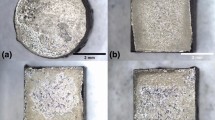Abstract
Isothermal solidification stage during transient liquid phase bonding is the key to preclude intermetallic phase formation during solidification of the liquid phase. The rate of isothermal solidification is controlled by solid-state diffusion. Therefore, the bonding time required to complete isothermal solidification is generally long. This paper reports a very short isothermal solidification time for transient liquid phase bonding of IN617 solid solution nickel-based superalloy using a boron-containing filler metal. A eutectic-free bond with limited grain growth in the base material with high shear strength is achievable by utilizing a short (i.e., 5 minutes) thermal bonding strategy. The fast isothermal solidification of IN617 is unveiled by considering the role of in-situ boride precipitation during TLP bonding. The presence of a high amount of boride-forming elements (Cr and Mo) in the base material composition promotes the formation of a high volume fraction of the boride precipitates in the diffusion affected zone. The boron-free regions in the vicinity of boride precipitates cause a steep concentration gradient for boron diffusion during isothermal solidification, which enables fast isothermal solidification.












Similar content being viewed by others
Notes
It is interesting to note that the boride formation reaction is believed to be exothermic.[31] Therefore, the deviation from the nominal bonding temperature may take place locally due to the formation of boride precipitates through exothermic reactions. However, the whole setup can reach to the nominal bonding temperature again as the generated heat can be easily dissipated by the surrounding especially when the size of bonded samples is large. In light of this scenario, it is believed that the isothermal solidification conditions are met during TLP bonding process.
References
M. Mosallaee, A. Ekrami, K. Ohsasa, and K. Matsuura: Metall. Mater. Trans. A, 2008, vol. 39, pp. 2389.
AG. Bigvand and OA. Ojo: Metall. Mater. Trans. A, 2014, vol. 45, pp. 1670-4.
ED. Moreau and SF. Corbin: Metall. Mater. Trans. A, 2019, vol. 50, pp. 5678–5688.
O.A. Idowu, O.A. Ojo, and M.C. Chaturvedi: Metall. Mater. Trans. A, 2006, vol. 37, pp. 2787-96.
M. Kapoor, Ö.N. Doğan, C.S. Carney, R.V. Saranam, P. McNeff, and B.K. Paul: Metall. Mater. Trans. A. 2017, vol. 48, pp. 3343-56.
O.A. Idowu, N.L. Richards, and M.C. Chaturvedi: Mater. Sci. Eng. A, 2005, vol. 397, pp. 98-112.
OJ. Adebajo and OA. Ojo: Metall. Mater. Trans. A, 2017, vol. 48, pp. 26-33.
WD. MacDonald and TW. Eagar: Annu. Rev. Mater. Sci., 1992, vol. 22, pp. 23-46.
D.S. Duvall, W.A. Owczarski, and D.F. Paulonis: Weld. J., 1974, vol. 53, pp. 203-14.
W.F. Gale and E.R. Wallach: Mater. Sci. Technol., 1991, vol. 7, pp. 1143-1148.
A. Ghasemi and M. Pouranvari: Metall. Mater. Trans. A, 2019, vol. 50, pp. 2235-2245.
MM. Abdelfatah and OA. Ojo: Metall. Mater. Trans. A, 2009, vol. 40, pp.377-85.
N. Sheng, J. Liu, T. Jin, X. Sun, and Z. Hu: Metall. Mater. Trans. A, 2015, vol. 46, pp. 5772-81.
A. Ghasemi and M. Pouranvari: Technol. Weld. Joi., 2019, vol. 24, pp. 342-51.
A. Ghasemi and M. Pouranvari: Sci. Technol. Weld. Joi., 2018, vol. 23, pp.441-8.
A. Ghasemi and M. Pouranvari: Mater. Des., 2019, vol. 182, pp. 108008.
M. Pouranvari, A. Ekrami, and A.H. Kokabi: J. Alloy. Compd. 2017, vol. 723, pp. 84-91.
N.C. Sheng, J.D. Liu, T. Jin, X.F. Sun, and Z.Q. Hu: Metall. Mater. Trans. A, 2013, vol. 44, pp. 1793-804.
N. Sheng, J. Liu, T. Jin, X. Sun, and Z. Hu: Philos. Mag. 2014, vol. 94, pp. 1219-34.
A. Ghoneim and OA. Ojo: Metall. Mater. Trans. A, 2012, vol. 43, pp. 900-11.
M. Pouranvari, A. Ekrami, and A.H. Kokabi: Sci. Technol. Weld. Joi., 2018, vol. 23, pp. 13-18.
M. Pouranvari, A. Ekrami, and A.H. Kokabi: Mater. Sci. Eng. A, 2008, vol. 490, pp. 229-34.
WF. Gale and ER. Wallach: Metall. Trans. A, 1991, vol. 22, pp. 2451-7.
F. Jalilian, M. Jahazi, and R.A. Drew: Mater. Sci. Eng. A, 2006, vol. 423, pp. 269-81.
R. B. McLellan, Scripta Metallurgica et Materialia, 1995, vol.33, pp.1265-1267.
M. Pouranvari, A. Ekrami, and A.H. Kokabi: Weld. J., 2014, vol. 93, pp. 60s-68s.
TB Massalski (ed.) (1986) Binary Alloy Phase Diagrams. Metals Park, OH: ASM.
O.A. Ojo, N.L. Richards, and M.C. Chaturvedi: Sci. Technol. Weld. Joi., 2004, vol. 9, pp. 532–540.
M. Pouranvari, A. Ekrami, and A.H. Kokabi: Can. Metall. Q., 2014, vol. 53 pp. 38-46.
Y. Nakao, K. Nishimoto, K. Shinozaki, and C. Kang: Trans. Japan Weld. Soc., 1989, vol. 20, pp. 60-5.
M. Zhang, H. Wang, H. Wang, T. Cui, and Y. Ma: Journal of Physical Chemistry C, 2010, vol. 114, pp. 6722-5.
Y. Zhou, W.F. Gale, and T. H. North: Int. Mater Rev., 1992, vol. 40, pp. 181-196.
I.Tuah-Poku, M. Dollar and T.B.Massalaski: Metall. Mater. Trans. A, 1998, vol. 19A, pp. 675-685.
W.D. MacDonald: Kinetics of Transient Liquid Phase Bonding, Doctoral dissertation, Massachusetts Institute of Technology.
D. A. Porter, K. E. Easterling, M. Sherif, Phase Transformations in Metals and Alloys, CRC Press, New York, 2009.
L. Priester, Grain Boundaries: From Theory to Engineering, Springer, Dordrecht, 2013.
M. Pouranvari: Mater. Sci. Technol, 2015, vol. 31, pp. 1773-1780.
Acknowledgment
This research was supported by Iran National Science Foundation (INSF) under Grant No. 96006047.
Author information
Authors and Affiliations
Corresponding author
Additional information
Publisher's Note
Springer Nature remains neutral with regard to jurisdictional claims in published maps and institutional affiliations.
Manuscript submitted October 19, 2019.
Rights and permissions
About this article
Cite this article
Hosseini, M., Ghasemi, A. & Pouranvari, M. High Content of Boride-Forming Elements in IN617 Nickel-Based Superalloy Enables Short Isothermal Solidification Time During Transient Liquid Phase Bonding. Metall Mater Trans A 51, 5715–5724 (2020). https://doi.org/10.1007/s11661-020-05935-6
Received:
Accepted:
Published:
Issue Date:
DOI: https://doi.org/10.1007/s11661-020-05935-6




